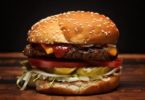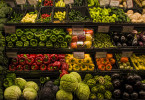Homer Simpson is the Platonic ideal of American obesity. He drinks like a sailor, eats enough donuts to give Satan himself pause, and once ingested a handful of Play-Doh to nudge himself onto disability benefit. But, astonishingly, some of his dietary habits are sound – even if they’re outweighed by all the other terrible ones. Here’s how you can eat more like a man who once failed to fit into a voting booth – and get healthier.
Mmmm…buttered coffee
If you remember the episode where Homer discovers the gym and climbs the Murderhorn, you may also remember that he’s nudged into it by failing horribly during a gentle game of capture the flag – cue lamentations about how much he’s let himself go. Marge’s response? ‘I’m not the one who puts butter in your coffee.’
Ha, right? What kind of glutton does that? Well, as you may already be aware, buttered coffee is the hot new thing among fitness professionals and self-experimenting body-hackers, who claim that – as a breakfast – it can keep you sated for hours, give you unprecedented levels of mental energy, and ‘programme’ your body to burn fat as its primary energy source. It’s all down to the fact that grass-fed butter – probably not the kind Homer uses – is a good source of healthy fat, and has the right ratios of omega-3 fatty acids (good) to omega-6 (generally speaking, bad). This guy has built his own coffee brand off the back off it, after first trying it with Tibetan yak butter – it’s popular with sherpas, apparently. If you fancy giving it a try, make yourself a half-litre of coffee and mix in around two tablespoons of butter (more is possible, but see whether you like the taste first). You could also try coconut oil – some nutritionists even recommend egg yolks, though there are obvious salmonella-based drawbacks to that. The real takeaway is that fat is not to be feared, and it’s a message that’s finally percolating through to mainstream society – even Time magazine recently ran a piece on it. Butter, certainly, is preferable to margarine and other substitutes, since it’s less full of horrendous additives and preservatives. Remember, though – ideally, this is a substitute for breakfast, not something to eat alongside a huge plate of bacon. Although that brings us to…
Mmmm…bacon-sausage
‘Bacon up that sausage, boy.’ It’s the sort of parental command that would have childhood-obesity campaigners up in arms, especially after (as in the episode) Bart’s already buttered up his bacon. Won’t somebody think of the trans-fats?
Well, except that this is exactly the sort of meal that Gary Taubes, respected obesity authority and bestselling author of Good Calories, Bad Calories (and its easier-to-digest sequel, Why We Get Fat) recommends, and personally eats, on a near-daily basis. Taubes’ argument, in brief, is that eating carbohydrates (especially refined carbohydrates, like you get in bread and pasta), drives the body to release insulin, which can lead to insulin resistance and, eventually, diabetes. It’ll also, he argues, lead to your body storing excess carbohydrates in fat cells, for energy. His solution? Cut the carbohydrates, forcing your body to enter a state known as ketosis, where it’ll burn fatty triglycerides for energy instead. According to Taubes: “I eat eggs and bacon or sausage for breakfast every day. At lunch, I might have three quarters of a pound of hamburger with cheese, no bun. Dinner is a pound of steak or half a roast chicken or the largest piece of fish I can buy,
and vegetables. You eat what you want until you’re satiated—you just don’t eat the things that will make you fat.’
Sounds good? You don’t have to go that far, but the message is clear: fat isn’t the problem – sugar and refined carbs are. Oh, and another caveat: you should probably be eating decent-quality sausage and bacon to avoid the nasty processed additives used to bulk out or preserve the budget versions.’
Mmmm…Guatemalan Insanity pepper
Even if they existed, it would probably not be a good idea to eat the the Merciless Peppers of Quetzalacatenango – grown, according to Chief Wiggum, ‘Deep in the jungle primeval by the inmates of a Guatemalan insane asylum.’ But generally, Marge’s attempts to steer Homer away from the annual Chili Cook-Off are as misguided as they are doomed: since it’s actually possible that the big man’s love of all things spicy is one of the only things keeping him alive.
Sad fact: when many people decide to eat more healthily, they seem to do it based on some half-remembered version of what bodybuilders ate in the 1980s – endless dry chicken breasts and broccoli, unseasoned and scooped grudgingly from tupperware tubs. This is ridiculous for many reasons, but here’s the key one: herbs and spices not only make things delicious, they make you healthier. Cumin, for instance, aids memory and metabolism and lowers stress, cinnamon lowers blood sugar, turmeric improves liver function and heart health and protects against everything from Alzheimer’s to leukemia, and capsaicin, which is what makes peppers spicy, improves mood, reduces pain, reduces inflammation, burns fat, and has cancer-fighting properties. Obviously the fresher the better, but the message is simple: use spices when you cook. Not only do they make your food taste like actual, you know, food, but they’ll make you healthier in almost every way. They won’t let you hallucinate a coyote version of Johnny Cash, but it’s tough to say whether that’d be beneficial anyway.
Mmmm…free-range lobster
When Homer acquires a lobster (called Pinchy), there’s only one clear endgame in sight: and sure enough, after all sorts of adventures and Marge-baiting hijinks, Pinchy goes for a bath. A hot bath. Commendably, though, Homer does not waste food, even if it was once a loyal pet. ‘Man that’s good,’ he notes, between grief-wracked sobs. ‘Pass the butter.’
Should you eat more lobster? Debatable. The real lesson here, though, is that hand-reared, carefully-raised produce doesn’t just taste better – it’s also better for you. To quote Paleo Solution author Robb Wolf: ‘One of the greatest deviations away from our ancestral diet is the amounts and types of fat found in modern grain feed animals vs. the amounts and types of fats found in grass fed or wild meat, fowl and fish. What we observe is wild meat is remarkably lean, and has relatively low amounts of saturated fats, while supplying significant amounts of beneficial omega-3 fats such as EPA and DHA.’ To caveat this a bit, eating a free-range, grass-fed cow isn’t exaclty ‘wild’ meat, but it’s certainly better for you than eating the factory-farmed, stress-hormone-filled, horror-filled alternative. The take-home message? If you could nurture all your food in a loving environment – and then kill it and it eat – you’d probably be much healthier than you are. Since that probably isn’t an option, stick to free-range and grass-fed.
So, in conclusion, here’s what you can learn from the Homer Simpson Diet:
- Switch margarine for butter – and don’t be afraid to eat good sources of fat.
- Eat high-quality meat and cut down on refined carbs.
- Cook with spices as much as you can.
- Go free-range wherever possible.
Oh, and don’t eat any of the following: three-week old sandwiches, compressed spaghetti bars, all the doughnuts in the world or a tiny bicycle. There are limits, after all.





lol well written. The trouble with Homer is his Leptin regulation is non-existent. He’s always hungry.